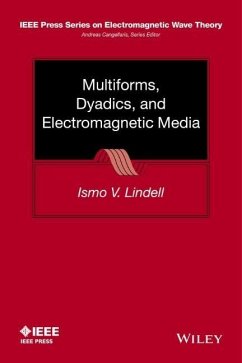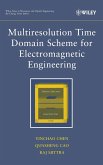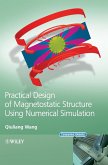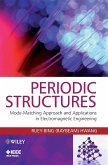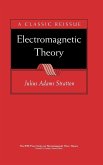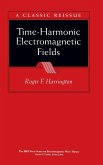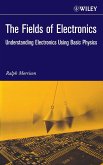- Gebundenes Buch
- Merkliste
- Auf die Merkliste
- Bewerten Bewerten
- Teilen
- Produkt teilen
- Produkterinnerung
- Produkterinnerung
This book applies the four-dimensional formalism with an extended toolbox of operation rules, allowing readers to define more general classes of electromagnetic media and to analyze EM waves that can exist in them
End-of-chapter exercises
Formalism allows readers to find novel classes of media
Covers various properties of electromagnetic media in terms of which they can be set in different classes
Andere Kunden interessierten sich auch für
![Multiresolution Time Domain Scheme for Electromagnetic Engineering Multiresolution Time Domain Scheme for Electromagnetic Engineering]() Yinchao ChenMultiresolution Time Domain Scheme for Electromagnetic Engineering195,99 €
Yinchao ChenMultiresolution Time Domain Scheme for Electromagnetic Engineering195,99 €![Magnetostatic C Magnetostatic C]() S. X. WangMagnetostatic C175,99 €
S. X. WangMagnetostatic C175,99 €![Electromagnetic Fields 2E Electromagnetic Fields 2E]() Jean G. Van BladelElectromagnetic Fields 2E251,99 €
Jean G. Van BladelElectromagnetic Fields 2E251,99 €![Periodic Structures C Periodic Structures C]() Ruey-Bing Hwang (Raybeam)Periodic Structures C182,99 €
Ruey-Bing Hwang (Raybeam)Periodic Structures C182,99 €![Electromagnetic Theory Electromagnetic Theory]() Julius Adams StrattonElectromagnetic Theory173,99 €
Julius Adams StrattonElectromagnetic Theory173,99 €![Time-Harmonic Electromagnetic Fields Time-Harmonic Electromagnetic Fields]() Roger F. HarringtonTime-Harmonic Electromagnetic Fields205,99 €
Roger F. HarringtonTime-Harmonic Electromagnetic Fields205,99 €![The Fields of Electronics The Fields of Electronics]() Ralph MorrisonThe Fields of Electronics136,99 €
Ralph MorrisonThe Fields of Electronics136,99 €-
-
-
This book applies the four-dimensional formalism with an extended toolbox of operation rules, allowing readers to define more general classes of electromagnetic media and to analyze EM waves that can exist in them
End-of-chapter exercises
Formalism allows readers to find novel classes of media
Covers various properties of electromagnetic media in terms of which they can be set in different classes
Hinweis: Dieser Artikel kann nur an eine deutsche Lieferadresse ausgeliefert werden.
End-of-chapter exercises
Formalism allows readers to find novel classes of media
Covers various properties of electromagnetic media in terms of which they can be set in different classes
Hinweis: Dieser Artikel kann nur an eine deutsche Lieferadresse ausgeliefert werden.
Produktdetails
- Produktdetails
- IEEE/OUP Press Series on Electromagnetic Wave Theory
- Verlag: Wiley & Sons
- 1. Auflage
- Seitenzahl: 416
- Erscheinungstermin: 23. März 2015
- Englisch
- Abmessung: 238mm x 177mm x 29mm
- Gewicht: 844g
- ISBN-13: 9781118989333
- ISBN-10: 1118989333
- Artikelnr.: 41122978
- Herstellerkennzeichnung
- Libri GmbH
- Europaallee 1
- 36244 Bad Hersfeld
- gpsr@libri.de
- IEEE/OUP Press Series on Electromagnetic Wave Theory
- Verlag: Wiley & Sons
- 1. Auflage
- Seitenzahl: 416
- Erscheinungstermin: 23. März 2015
- Englisch
- Abmessung: 238mm x 177mm x 29mm
- Gewicht: 844g
- ISBN-13: 9781118989333
- ISBN-10: 1118989333
- Artikelnr.: 41122978
- Herstellerkennzeichnung
- Libri GmbH
- Europaallee 1
- 36244 Bad Hersfeld
- gpsr@libri.de
Ismo V. Lindell is a Professor Emeritus in the Department of Radio Science and Engineering, in the School of Electrical Engineering at the Aalto University, Finland. Dr. Lindell has received many honors in the course of his career, including his recognition as an IEEE Fellow in 1990 for his contributions to electromagnetic theory and for the development of education in electromagnetics in Finland. Dr. Lindell has authored or co-authored 3 books in English, authored or co-authored 10 books in Finnish, and published several hundred articles in professional journals, conference proceedings, and contributed chapters to other books.
Preface xi 1 Multivectors and Multiforms 1 1.1 Vectors and One-Forms, 1 1.1.1 Bar Product 1 1.1.2 Basis Expansions 2 1.2 Bivectors and Two-Forms, 3 1.2.1 Wedge Product
3 1.2.2 Basis Expansions 4 1.2.3 Bar Product 5 1.2.4 Contraction Products
and
6 1.2.5 Decomposition of Vectors and One-Forms 8 1.3 Multivectors and Multiforms, 8 1.3.1 Basis of Multivectors 9 1.3.2 Bar Product of Multivectors and Multiforms 10 1.3.3 Contraction of Trivectors and Three-Forms 11 1.3.4 Contraction of Quadrivectors and Four-Forms 12 1.3.5 Construction of Reciprocal Basis 13 1.3.6 Contraction of Quintivector 14 1.3.7 Generalized Bac-Cab Rules 14 1.4 Some Properties of Bivectors and Two-Forms, 16 1.4.1 Bivector Invariant 16 1.4.2 Natural Dot Product 17 1.4.3 Bivector as Mapping 17 Problems, 18 2 Dyadics 21 2.1 Mapping Vectors and One-Forms, 21 2.1.1 Dyadics 21 2.1.2 Double-Bar Product 23 2.1.3 Metric Dyadics 24 2.2 Mapping Multivectors and Multiforms, 25 2.2.1 Bidyadics 25 2.2.2 Double-Wedge Product
2.2.3 Double-Wedge Powers 28 2.2.4 Double Contractions
and
30 2.2.5 Natural Dot Product for Bidyadics 31 2.3 Dyadic Identities, 32 2.3.1 Contraction Identities 32 2.3.2 Special Cases 33 2.3.3 More General Rules 35 2.3.4 Cayley-Hamilton Equation 36 2.3.5 Inverse Dyadics 36 2.4 Rank of Dyadics, 39 2.5 Eigenproblems, 41 2.5.1 Eigenvectors and Eigen One-Forms 41 2.5.2 Reduced Cayley-Hamilton Equations 42 2.5.3 Construction of Eigenvectors 43 2.6 Metric Dyadics, 45 2.6.1 Symmetric Dyadics 46 2.6.2 Antisymmetric Dyadics 47 2.6.3 Inverse Rules for Metric Dyadics 48 Problems, 49 3 Bidyadics 53 3.1 Cayley-Hamilton Equation, 54 3.1.1 Coefficient Functions 55 3.1.2 Determinant of a Bidyadic 57 3.1.3 Antisymmetric Bidyadic 57 3.2 Bidyadic Eigenproblem, 58 3.2.1 Eigenbidyadic C
60 3.2.2 Eigenbidyadic C+ 60 3.3 Hehl-Obukhov Decomposition, 61 3.4 Example: Simple Antisymmetric Bidyadic, 64 3.5 Inverse Rules for Bidyadics, 66 3.5.1 Skewon Bidyadic 67 3.5.2 Extended Bidyadics 70 3.5.3 3D Expansions 73 Problems, 74 4 Special Dyadics and Bidyadics 79 4.1 Orthogonality Conditions, 79 4.1.1 Orthogonality of Dyadics 79 4.1.2 Orthogonality of Bidyadics 81 4.2 Nilpotent Dyadics and Bidyadics, 81 4.3 Projection Dyadics and Bidyadics, 83 4.4 Unipotent Dyadics and Bidyadics, 85 4.5 Almost-Complex Dyadics, 87 4.5.1 Two-Dimensional AC Dyadics 89 4.5.2 Four-Dimensional AC Dyadics 89 4.6 Almost-Complex Bidyadics, 91 4.7 Modified Closure Relation, 93 4.7.1 Equivalent Conditions 94 4.7.2 Solutions 94 4.7.3 Testing the Two Solutions 96 Problems, 98 5 Electromagnetic Fields 101 5.1 Field Equations, 101 5.1.1 Differentiation Operator 101 5.1.2 Maxwell Equations 103 5.1.3 Potential One-Form 105 5.2 Medium Equations, 106 5.2.1 Medium Bidyadics 106 5.2.2 Potential Equation 107 5.2.3 Expansions of Medium Bidyadics 107 5.2.4 Gibbsian Representation 109 5.3 Basic Classes of Media, 110 5.3.1 Hehl-Obukhov Decomposition 110 5.3.2 3D Expansions 112 5.3.3 Simple Principal Medium 114 5.4 Interfaces and Boundaries, 117 5.4.1 Interface Conditions 117 5.4.2 Boundary Conditions 119 5.5 Power and Energy, 123 5.5.1 Bilinear Invariants 123 5.5.2 The Stress-Energy Dyadic 125 5.5.3 Differentiation Rule 127 5.6 Plane Waves, 128 5.6.1 Basic Equations 128 5.6.2 Dispersion Equation 130 5.6.3 Special Cases 132 5.6.4 Plane-Wave Fields 132 5.6.5 Simple Principal Medium 134 5.6.6 Handedness of Plane Wave 135 Problems, 136 6 Transformation of Fields and Media 141 6.1 Affine Transformation, 141 6.1.1 Transformation of Fields 141 6.1.2 Transformation of Media 142 6.1.3 Dispersion Equation 144 6.1.4 Simple Principal Medium 145 6.2 Duality Transformation, 145 6.2.1 Transformation of Fields 146 6.2.2 Involutionary Duality Transformation 147 6.2.3 Transformation of Media 149 6.3 Transformation of Boundary Conditions, 150 6.3.1 Simple Principal Medium 152 6.3.2 Plane Wave 152 6.4 Reciprocity Transformation, 153 6.4.1 Medium Transformation 153 6.4.2 Reciprocity Conditions 155 6.4.3 Field Relations 157 6.4.4 Time-Harmonic Fields 158 6.5 Conformal Transformation, 159 6.5.1 Properties of the Conformal Transformation 160 6.5.2 Field Transformation 164 6.5.3 Medium Transformation 165 Problems, 166 7 Basic Classes of Electromagnetic Media 169 7.1 Gibbsian Isotropy, 169 7.1.1 Gibbsian Isotropic Medium 169 7.1.2 Gibbsian Bi-isotropic Medium 170 7.1.3 Decomposition of GBI Medium 171 7.1.4 Affine Transformation 173 7.1.5 Eigenfields in GBI Medium 174 7.1.6 Plane Wave in GBI Medium 176 7.2 The Axion Medium, 178 7.2.1 Perfect Electromagnetic Conductor 179 7.2.2 PEMC as Limiting Case of GBI Medium 180 7.2.3 PEMC Boundary Problems 181 7.3 Skewon-Axion Media, 182 7.3.1 Plane Wave in Skewon-Axion Medium 184 7.3.2 Gibbsian Representation 185 7.3.3 Boundary Conditions 187 7.4 Extended Skewon-Axion Media, 192 Problems, 194 8 Quadratic Media 197 8.1 P Media and Q Media, 197 8.2 Transformations, 200 8.3 Spatial Expansions, 201 8.3.1 Spatial Expansion of Q Media 201 8.3.2 Spatial Expansion of P Media 203 8.3.3 Relation Between P Media and Q Media 204 8.4 Plane Waves, 205 8.4.1 Plane Waves in Q Media 205 8.4.2 Plane Waves in P Media 207 8.4.3 P Medium as Boundary Material 208 8.5 P-Axion and Q-Axion Media, 209 8.6 Extended Q Media, 211 8.6.1 Gibbsian Representation 211 8.6.2 Field Decomposition 214 8.6.3 Transformations 215 8.6.4 Plane Waves in Extended Q Media 215 8.7 Extended P Media, 218 8.7.1 Medium Conditions 218 8.7.2 Plane Waves in Extended P Media 219 8.7.3 Field Conditions 220 Problems, 221 9 Media Defined by Bidyadic Equations 225 9.1 Quadratic Equation, 226 9.1.1 SD Media 227 9.1.2 Eigenexpansions 228 9.1.3 Duality Transformation 229 9.1.4 3D Representations 231 9.1.5 SDN Media 234 9.2 Cubic Equation, 235 9.2.1 CU Media 235 9.2.2 Eigenexpansions 236 9.2.3 Examples of CU Media 238 9.3 Bi-Quadratic Equation, 240 9.3.1 BQ Media 241 9.3.2 Eigenexpansions 242 9.3.3 3D Representation 244 9.3.4 Special Case 245 Problems, 246 10 Media Defined by Plane-Wave Properties 249 10.1 Media with No Dispersion Equation (NDE Media), 249 10.1.1 Two Cases of Solutions 250 10.1.2 Plane-Wave Fields in NDE Media 255 10.1.3 Other Possible NDE Media 257 10.2 Decomposable Media, 259 10.2.1 Special Cases 259 10.2.2 DC-Medium Subclasses 263 10.2.3 Plane-Wave Properties 267 Problems, 269 Appendix A Solutions to Problems 273 Appendix B Transformation to Gibbsian Formalism 369 Appendix C Multivector and Dyadic Identities 375 References 389 Index 395
3 1.2.2 Basis Expansions 4 1.2.3 Bar Product 5 1.2.4 Contraction Products
and
6 1.2.5 Decomposition of Vectors and One-Forms 8 1.3 Multivectors and Multiforms, 8 1.3.1 Basis of Multivectors 9 1.3.2 Bar Product of Multivectors and Multiforms 10 1.3.3 Contraction of Trivectors and Three-Forms 11 1.3.4 Contraction of Quadrivectors and Four-Forms 12 1.3.5 Construction of Reciprocal Basis 13 1.3.6 Contraction of Quintivector 14 1.3.7 Generalized Bac-Cab Rules 14 1.4 Some Properties of Bivectors and Two-Forms, 16 1.4.1 Bivector Invariant 16 1.4.2 Natural Dot Product 17 1.4.3 Bivector as Mapping 17 Problems, 18 2 Dyadics 21 2.1 Mapping Vectors and One-Forms, 21 2.1.1 Dyadics 21 2.1.2 Double-Bar Product 23 2.1.3 Metric Dyadics 24 2.2 Mapping Multivectors and Multiforms, 25 2.2.1 Bidyadics 25 2.2.2 Double-Wedge Product
2.2.3 Double-Wedge Powers 28 2.2.4 Double Contractions
and
30 2.2.5 Natural Dot Product for Bidyadics 31 2.3 Dyadic Identities, 32 2.3.1 Contraction Identities 32 2.3.2 Special Cases 33 2.3.3 More General Rules 35 2.3.4 Cayley-Hamilton Equation 36 2.3.5 Inverse Dyadics 36 2.4 Rank of Dyadics, 39 2.5 Eigenproblems, 41 2.5.1 Eigenvectors and Eigen One-Forms 41 2.5.2 Reduced Cayley-Hamilton Equations 42 2.5.3 Construction of Eigenvectors 43 2.6 Metric Dyadics, 45 2.6.1 Symmetric Dyadics 46 2.6.2 Antisymmetric Dyadics 47 2.6.3 Inverse Rules for Metric Dyadics 48 Problems, 49 3 Bidyadics 53 3.1 Cayley-Hamilton Equation, 54 3.1.1 Coefficient Functions 55 3.1.2 Determinant of a Bidyadic 57 3.1.3 Antisymmetric Bidyadic 57 3.2 Bidyadic Eigenproblem, 58 3.2.1 Eigenbidyadic C
60 3.2.2 Eigenbidyadic C+ 60 3.3 Hehl-Obukhov Decomposition, 61 3.4 Example: Simple Antisymmetric Bidyadic, 64 3.5 Inverse Rules for Bidyadics, 66 3.5.1 Skewon Bidyadic 67 3.5.2 Extended Bidyadics 70 3.5.3 3D Expansions 73 Problems, 74 4 Special Dyadics and Bidyadics 79 4.1 Orthogonality Conditions, 79 4.1.1 Orthogonality of Dyadics 79 4.1.2 Orthogonality of Bidyadics 81 4.2 Nilpotent Dyadics and Bidyadics, 81 4.3 Projection Dyadics and Bidyadics, 83 4.4 Unipotent Dyadics and Bidyadics, 85 4.5 Almost-Complex Dyadics, 87 4.5.1 Two-Dimensional AC Dyadics 89 4.5.2 Four-Dimensional AC Dyadics 89 4.6 Almost-Complex Bidyadics, 91 4.7 Modified Closure Relation, 93 4.7.1 Equivalent Conditions 94 4.7.2 Solutions 94 4.7.3 Testing the Two Solutions 96 Problems, 98 5 Electromagnetic Fields 101 5.1 Field Equations, 101 5.1.1 Differentiation Operator 101 5.1.2 Maxwell Equations 103 5.1.3 Potential One-Form 105 5.2 Medium Equations, 106 5.2.1 Medium Bidyadics 106 5.2.2 Potential Equation 107 5.2.3 Expansions of Medium Bidyadics 107 5.2.4 Gibbsian Representation 109 5.3 Basic Classes of Media, 110 5.3.1 Hehl-Obukhov Decomposition 110 5.3.2 3D Expansions 112 5.3.3 Simple Principal Medium 114 5.4 Interfaces and Boundaries, 117 5.4.1 Interface Conditions 117 5.4.2 Boundary Conditions 119 5.5 Power and Energy, 123 5.5.1 Bilinear Invariants 123 5.5.2 The Stress-Energy Dyadic 125 5.5.3 Differentiation Rule 127 5.6 Plane Waves, 128 5.6.1 Basic Equations 128 5.6.2 Dispersion Equation 130 5.6.3 Special Cases 132 5.6.4 Plane-Wave Fields 132 5.6.5 Simple Principal Medium 134 5.6.6 Handedness of Plane Wave 135 Problems, 136 6 Transformation of Fields and Media 141 6.1 Affine Transformation, 141 6.1.1 Transformation of Fields 141 6.1.2 Transformation of Media 142 6.1.3 Dispersion Equation 144 6.1.4 Simple Principal Medium 145 6.2 Duality Transformation, 145 6.2.1 Transformation of Fields 146 6.2.2 Involutionary Duality Transformation 147 6.2.3 Transformation of Media 149 6.3 Transformation of Boundary Conditions, 150 6.3.1 Simple Principal Medium 152 6.3.2 Plane Wave 152 6.4 Reciprocity Transformation, 153 6.4.1 Medium Transformation 153 6.4.2 Reciprocity Conditions 155 6.4.3 Field Relations 157 6.4.4 Time-Harmonic Fields 158 6.5 Conformal Transformation, 159 6.5.1 Properties of the Conformal Transformation 160 6.5.2 Field Transformation 164 6.5.3 Medium Transformation 165 Problems, 166 7 Basic Classes of Electromagnetic Media 169 7.1 Gibbsian Isotropy, 169 7.1.1 Gibbsian Isotropic Medium 169 7.1.2 Gibbsian Bi-isotropic Medium 170 7.1.3 Decomposition of GBI Medium 171 7.1.4 Affine Transformation 173 7.1.5 Eigenfields in GBI Medium 174 7.1.6 Plane Wave in GBI Medium 176 7.2 The Axion Medium, 178 7.2.1 Perfect Electromagnetic Conductor 179 7.2.2 PEMC as Limiting Case of GBI Medium 180 7.2.3 PEMC Boundary Problems 181 7.3 Skewon-Axion Media, 182 7.3.1 Plane Wave in Skewon-Axion Medium 184 7.3.2 Gibbsian Representation 185 7.3.3 Boundary Conditions 187 7.4 Extended Skewon-Axion Media, 192 Problems, 194 8 Quadratic Media 197 8.1 P Media and Q Media, 197 8.2 Transformations, 200 8.3 Spatial Expansions, 201 8.3.1 Spatial Expansion of Q Media 201 8.3.2 Spatial Expansion of P Media 203 8.3.3 Relation Between P Media and Q Media 204 8.4 Plane Waves, 205 8.4.1 Plane Waves in Q Media 205 8.4.2 Plane Waves in P Media 207 8.4.3 P Medium as Boundary Material 208 8.5 P-Axion and Q-Axion Media, 209 8.6 Extended Q Media, 211 8.6.1 Gibbsian Representation 211 8.6.2 Field Decomposition 214 8.6.3 Transformations 215 8.6.4 Plane Waves in Extended Q Media 215 8.7 Extended P Media, 218 8.7.1 Medium Conditions 218 8.7.2 Plane Waves in Extended P Media 219 8.7.3 Field Conditions 220 Problems, 221 9 Media Defined by Bidyadic Equations 225 9.1 Quadratic Equation, 226 9.1.1 SD Media 227 9.1.2 Eigenexpansions 228 9.1.3 Duality Transformation 229 9.1.4 3D Representations 231 9.1.5 SDN Media 234 9.2 Cubic Equation, 235 9.2.1 CU Media 235 9.2.2 Eigenexpansions 236 9.2.3 Examples of CU Media 238 9.3 Bi-Quadratic Equation, 240 9.3.1 BQ Media 241 9.3.2 Eigenexpansions 242 9.3.3 3D Representation 244 9.3.4 Special Case 245 Problems, 246 10 Media Defined by Plane-Wave Properties 249 10.1 Media with No Dispersion Equation (NDE Media), 249 10.1.1 Two Cases of Solutions 250 10.1.2 Plane-Wave Fields in NDE Media 255 10.1.3 Other Possible NDE Media 257 10.2 Decomposable Media, 259 10.2.1 Special Cases 259 10.2.2 DC-Medium Subclasses 263 10.2.3 Plane-Wave Properties 267 Problems, 269 Appendix A Solutions to Problems 273 Appendix B Transformation to Gibbsian Formalism 369 Appendix C Multivector and Dyadic Identities 375 References 389 Index 395
Preface xi 1 Multivectors and Multiforms 1 1.1 Vectors and One-Forms, 1 1.1.1 Bar Product 1 1.1.2 Basis Expansions 2 1.2 Bivectors and Two-Forms, 3 1.2.1 Wedge Product
3 1.2.2 Basis Expansions 4 1.2.3 Bar Product 5 1.2.4 Contraction Products
and
6 1.2.5 Decomposition of Vectors and One-Forms 8 1.3 Multivectors and Multiforms, 8 1.3.1 Basis of Multivectors 9 1.3.2 Bar Product of Multivectors and Multiforms 10 1.3.3 Contraction of Trivectors and Three-Forms 11 1.3.4 Contraction of Quadrivectors and Four-Forms 12 1.3.5 Construction of Reciprocal Basis 13 1.3.6 Contraction of Quintivector 14 1.3.7 Generalized Bac-Cab Rules 14 1.4 Some Properties of Bivectors and Two-Forms, 16 1.4.1 Bivector Invariant 16 1.4.2 Natural Dot Product 17 1.4.3 Bivector as Mapping 17 Problems, 18 2 Dyadics 21 2.1 Mapping Vectors and One-Forms, 21 2.1.1 Dyadics 21 2.1.2 Double-Bar Product 23 2.1.3 Metric Dyadics 24 2.2 Mapping Multivectors and Multiforms, 25 2.2.1 Bidyadics 25 2.2.2 Double-Wedge Product
2.2.3 Double-Wedge Powers 28 2.2.4 Double Contractions
and
30 2.2.5 Natural Dot Product for Bidyadics 31 2.3 Dyadic Identities, 32 2.3.1 Contraction Identities 32 2.3.2 Special Cases 33 2.3.3 More General Rules 35 2.3.4 Cayley-Hamilton Equation 36 2.3.5 Inverse Dyadics 36 2.4 Rank of Dyadics, 39 2.5 Eigenproblems, 41 2.5.1 Eigenvectors and Eigen One-Forms 41 2.5.2 Reduced Cayley-Hamilton Equations 42 2.5.3 Construction of Eigenvectors 43 2.6 Metric Dyadics, 45 2.6.1 Symmetric Dyadics 46 2.6.2 Antisymmetric Dyadics 47 2.6.3 Inverse Rules for Metric Dyadics 48 Problems, 49 3 Bidyadics 53 3.1 Cayley-Hamilton Equation, 54 3.1.1 Coefficient Functions 55 3.1.2 Determinant of a Bidyadic 57 3.1.3 Antisymmetric Bidyadic 57 3.2 Bidyadic Eigenproblem, 58 3.2.1 Eigenbidyadic C
60 3.2.2 Eigenbidyadic C+ 60 3.3 Hehl-Obukhov Decomposition, 61 3.4 Example: Simple Antisymmetric Bidyadic, 64 3.5 Inverse Rules for Bidyadics, 66 3.5.1 Skewon Bidyadic 67 3.5.2 Extended Bidyadics 70 3.5.3 3D Expansions 73 Problems, 74 4 Special Dyadics and Bidyadics 79 4.1 Orthogonality Conditions, 79 4.1.1 Orthogonality of Dyadics 79 4.1.2 Orthogonality of Bidyadics 81 4.2 Nilpotent Dyadics and Bidyadics, 81 4.3 Projection Dyadics and Bidyadics, 83 4.4 Unipotent Dyadics and Bidyadics, 85 4.5 Almost-Complex Dyadics, 87 4.5.1 Two-Dimensional AC Dyadics 89 4.5.2 Four-Dimensional AC Dyadics 89 4.6 Almost-Complex Bidyadics, 91 4.7 Modified Closure Relation, 93 4.7.1 Equivalent Conditions 94 4.7.2 Solutions 94 4.7.3 Testing the Two Solutions 96 Problems, 98 5 Electromagnetic Fields 101 5.1 Field Equations, 101 5.1.1 Differentiation Operator 101 5.1.2 Maxwell Equations 103 5.1.3 Potential One-Form 105 5.2 Medium Equations, 106 5.2.1 Medium Bidyadics 106 5.2.2 Potential Equation 107 5.2.3 Expansions of Medium Bidyadics 107 5.2.4 Gibbsian Representation 109 5.3 Basic Classes of Media, 110 5.3.1 Hehl-Obukhov Decomposition 110 5.3.2 3D Expansions 112 5.3.3 Simple Principal Medium 114 5.4 Interfaces and Boundaries, 117 5.4.1 Interface Conditions 117 5.4.2 Boundary Conditions 119 5.5 Power and Energy, 123 5.5.1 Bilinear Invariants 123 5.5.2 The Stress-Energy Dyadic 125 5.5.3 Differentiation Rule 127 5.6 Plane Waves, 128 5.6.1 Basic Equations 128 5.6.2 Dispersion Equation 130 5.6.3 Special Cases 132 5.6.4 Plane-Wave Fields 132 5.6.5 Simple Principal Medium 134 5.6.6 Handedness of Plane Wave 135 Problems, 136 6 Transformation of Fields and Media 141 6.1 Affine Transformation, 141 6.1.1 Transformation of Fields 141 6.1.2 Transformation of Media 142 6.1.3 Dispersion Equation 144 6.1.4 Simple Principal Medium 145 6.2 Duality Transformation, 145 6.2.1 Transformation of Fields 146 6.2.2 Involutionary Duality Transformation 147 6.2.3 Transformation of Media 149 6.3 Transformation of Boundary Conditions, 150 6.3.1 Simple Principal Medium 152 6.3.2 Plane Wave 152 6.4 Reciprocity Transformation, 153 6.4.1 Medium Transformation 153 6.4.2 Reciprocity Conditions 155 6.4.3 Field Relations 157 6.4.4 Time-Harmonic Fields 158 6.5 Conformal Transformation, 159 6.5.1 Properties of the Conformal Transformation 160 6.5.2 Field Transformation 164 6.5.3 Medium Transformation 165 Problems, 166 7 Basic Classes of Electromagnetic Media 169 7.1 Gibbsian Isotropy, 169 7.1.1 Gibbsian Isotropic Medium 169 7.1.2 Gibbsian Bi-isotropic Medium 170 7.1.3 Decomposition of GBI Medium 171 7.1.4 Affine Transformation 173 7.1.5 Eigenfields in GBI Medium 174 7.1.6 Plane Wave in GBI Medium 176 7.2 The Axion Medium, 178 7.2.1 Perfect Electromagnetic Conductor 179 7.2.2 PEMC as Limiting Case of GBI Medium 180 7.2.3 PEMC Boundary Problems 181 7.3 Skewon-Axion Media, 182 7.3.1 Plane Wave in Skewon-Axion Medium 184 7.3.2 Gibbsian Representation 185 7.3.3 Boundary Conditions 187 7.4 Extended Skewon-Axion Media, 192 Problems, 194 8 Quadratic Media 197 8.1 P Media and Q Media, 197 8.2 Transformations, 200 8.3 Spatial Expansions, 201 8.3.1 Spatial Expansion of Q Media 201 8.3.2 Spatial Expansion of P Media 203 8.3.3 Relation Between P Media and Q Media 204 8.4 Plane Waves, 205 8.4.1 Plane Waves in Q Media 205 8.4.2 Plane Waves in P Media 207 8.4.3 P Medium as Boundary Material 208 8.5 P-Axion and Q-Axion Media, 209 8.6 Extended Q Media, 211 8.6.1 Gibbsian Representation 211 8.6.2 Field Decomposition 214 8.6.3 Transformations 215 8.6.4 Plane Waves in Extended Q Media 215 8.7 Extended P Media, 218 8.7.1 Medium Conditions 218 8.7.2 Plane Waves in Extended P Media 219 8.7.3 Field Conditions 220 Problems, 221 9 Media Defined by Bidyadic Equations 225 9.1 Quadratic Equation, 226 9.1.1 SD Media 227 9.1.2 Eigenexpansions 228 9.1.3 Duality Transformation 229 9.1.4 3D Representations 231 9.1.5 SDN Media 234 9.2 Cubic Equation, 235 9.2.1 CU Media 235 9.2.2 Eigenexpansions 236 9.2.3 Examples of CU Media 238 9.3 Bi-Quadratic Equation, 240 9.3.1 BQ Media 241 9.3.2 Eigenexpansions 242 9.3.3 3D Representation 244 9.3.4 Special Case 245 Problems, 246 10 Media Defined by Plane-Wave Properties 249 10.1 Media with No Dispersion Equation (NDE Media), 249 10.1.1 Two Cases of Solutions 250 10.1.2 Plane-Wave Fields in NDE Media 255 10.1.3 Other Possible NDE Media 257 10.2 Decomposable Media, 259 10.2.1 Special Cases 259 10.2.2 DC-Medium Subclasses 263 10.2.3 Plane-Wave Properties 267 Problems, 269 Appendix A Solutions to Problems 273 Appendix B Transformation to Gibbsian Formalism 369 Appendix C Multivector and Dyadic Identities 375 References 389 Index 395
3 1.2.2 Basis Expansions 4 1.2.3 Bar Product 5 1.2.4 Contraction Products
and
6 1.2.5 Decomposition of Vectors and One-Forms 8 1.3 Multivectors and Multiforms, 8 1.3.1 Basis of Multivectors 9 1.3.2 Bar Product of Multivectors and Multiforms 10 1.3.3 Contraction of Trivectors and Three-Forms 11 1.3.4 Contraction of Quadrivectors and Four-Forms 12 1.3.5 Construction of Reciprocal Basis 13 1.3.6 Contraction of Quintivector 14 1.3.7 Generalized Bac-Cab Rules 14 1.4 Some Properties of Bivectors and Two-Forms, 16 1.4.1 Bivector Invariant 16 1.4.2 Natural Dot Product 17 1.4.3 Bivector as Mapping 17 Problems, 18 2 Dyadics 21 2.1 Mapping Vectors and One-Forms, 21 2.1.1 Dyadics 21 2.1.2 Double-Bar Product 23 2.1.3 Metric Dyadics 24 2.2 Mapping Multivectors and Multiforms, 25 2.2.1 Bidyadics 25 2.2.2 Double-Wedge Product
2.2.3 Double-Wedge Powers 28 2.2.4 Double Contractions
and
30 2.2.5 Natural Dot Product for Bidyadics 31 2.3 Dyadic Identities, 32 2.3.1 Contraction Identities 32 2.3.2 Special Cases 33 2.3.3 More General Rules 35 2.3.4 Cayley-Hamilton Equation 36 2.3.5 Inverse Dyadics 36 2.4 Rank of Dyadics, 39 2.5 Eigenproblems, 41 2.5.1 Eigenvectors and Eigen One-Forms 41 2.5.2 Reduced Cayley-Hamilton Equations 42 2.5.3 Construction of Eigenvectors 43 2.6 Metric Dyadics, 45 2.6.1 Symmetric Dyadics 46 2.6.2 Antisymmetric Dyadics 47 2.6.3 Inverse Rules for Metric Dyadics 48 Problems, 49 3 Bidyadics 53 3.1 Cayley-Hamilton Equation, 54 3.1.1 Coefficient Functions 55 3.1.2 Determinant of a Bidyadic 57 3.1.3 Antisymmetric Bidyadic 57 3.2 Bidyadic Eigenproblem, 58 3.2.1 Eigenbidyadic C
60 3.2.2 Eigenbidyadic C+ 60 3.3 Hehl-Obukhov Decomposition, 61 3.4 Example: Simple Antisymmetric Bidyadic, 64 3.5 Inverse Rules for Bidyadics, 66 3.5.1 Skewon Bidyadic 67 3.5.2 Extended Bidyadics 70 3.5.3 3D Expansions 73 Problems, 74 4 Special Dyadics and Bidyadics 79 4.1 Orthogonality Conditions, 79 4.1.1 Orthogonality of Dyadics 79 4.1.2 Orthogonality of Bidyadics 81 4.2 Nilpotent Dyadics and Bidyadics, 81 4.3 Projection Dyadics and Bidyadics, 83 4.4 Unipotent Dyadics and Bidyadics, 85 4.5 Almost-Complex Dyadics, 87 4.5.1 Two-Dimensional AC Dyadics 89 4.5.2 Four-Dimensional AC Dyadics 89 4.6 Almost-Complex Bidyadics, 91 4.7 Modified Closure Relation, 93 4.7.1 Equivalent Conditions 94 4.7.2 Solutions 94 4.7.3 Testing the Two Solutions 96 Problems, 98 5 Electromagnetic Fields 101 5.1 Field Equations, 101 5.1.1 Differentiation Operator 101 5.1.2 Maxwell Equations 103 5.1.3 Potential One-Form 105 5.2 Medium Equations, 106 5.2.1 Medium Bidyadics 106 5.2.2 Potential Equation 107 5.2.3 Expansions of Medium Bidyadics 107 5.2.4 Gibbsian Representation 109 5.3 Basic Classes of Media, 110 5.3.1 Hehl-Obukhov Decomposition 110 5.3.2 3D Expansions 112 5.3.3 Simple Principal Medium 114 5.4 Interfaces and Boundaries, 117 5.4.1 Interface Conditions 117 5.4.2 Boundary Conditions 119 5.5 Power and Energy, 123 5.5.1 Bilinear Invariants 123 5.5.2 The Stress-Energy Dyadic 125 5.5.3 Differentiation Rule 127 5.6 Plane Waves, 128 5.6.1 Basic Equations 128 5.6.2 Dispersion Equation 130 5.6.3 Special Cases 132 5.6.4 Plane-Wave Fields 132 5.6.5 Simple Principal Medium 134 5.6.6 Handedness of Plane Wave 135 Problems, 136 6 Transformation of Fields and Media 141 6.1 Affine Transformation, 141 6.1.1 Transformation of Fields 141 6.1.2 Transformation of Media 142 6.1.3 Dispersion Equation 144 6.1.4 Simple Principal Medium 145 6.2 Duality Transformation, 145 6.2.1 Transformation of Fields 146 6.2.2 Involutionary Duality Transformation 147 6.2.3 Transformation of Media 149 6.3 Transformation of Boundary Conditions, 150 6.3.1 Simple Principal Medium 152 6.3.2 Plane Wave 152 6.4 Reciprocity Transformation, 153 6.4.1 Medium Transformation 153 6.4.2 Reciprocity Conditions 155 6.4.3 Field Relations 157 6.4.4 Time-Harmonic Fields 158 6.5 Conformal Transformation, 159 6.5.1 Properties of the Conformal Transformation 160 6.5.2 Field Transformation 164 6.5.3 Medium Transformation 165 Problems, 166 7 Basic Classes of Electromagnetic Media 169 7.1 Gibbsian Isotropy, 169 7.1.1 Gibbsian Isotropic Medium 169 7.1.2 Gibbsian Bi-isotropic Medium 170 7.1.3 Decomposition of GBI Medium 171 7.1.4 Affine Transformation 173 7.1.5 Eigenfields in GBI Medium 174 7.1.6 Plane Wave in GBI Medium 176 7.2 The Axion Medium, 178 7.2.1 Perfect Electromagnetic Conductor 179 7.2.2 PEMC as Limiting Case of GBI Medium 180 7.2.3 PEMC Boundary Problems 181 7.3 Skewon-Axion Media, 182 7.3.1 Plane Wave in Skewon-Axion Medium 184 7.3.2 Gibbsian Representation 185 7.3.3 Boundary Conditions 187 7.4 Extended Skewon-Axion Media, 192 Problems, 194 8 Quadratic Media 197 8.1 P Media and Q Media, 197 8.2 Transformations, 200 8.3 Spatial Expansions, 201 8.3.1 Spatial Expansion of Q Media 201 8.3.2 Spatial Expansion of P Media 203 8.3.3 Relation Between P Media and Q Media 204 8.4 Plane Waves, 205 8.4.1 Plane Waves in Q Media 205 8.4.2 Plane Waves in P Media 207 8.4.3 P Medium as Boundary Material 208 8.5 P-Axion and Q-Axion Media, 209 8.6 Extended Q Media, 211 8.6.1 Gibbsian Representation 211 8.6.2 Field Decomposition 214 8.6.3 Transformations 215 8.6.4 Plane Waves in Extended Q Media 215 8.7 Extended P Media, 218 8.7.1 Medium Conditions 218 8.7.2 Plane Waves in Extended P Media 219 8.7.3 Field Conditions 220 Problems, 221 9 Media Defined by Bidyadic Equations 225 9.1 Quadratic Equation, 226 9.1.1 SD Media 227 9.1.2 Eigenexpansions 228 9.1.3 Duality Transformation 229 9.1.4 3D Representations 231 9.1.5 SDN Media 234 9.2 Cubic Equation, 235 9.2.1 CU Media 235 9.2.2 Eigenexpansions 236 9.2.3 Examples of CU Media 238 9.3 Bi-Quadratic Equation, 240 9.3.1 BQ Media 241 9.3.2 Eigenexpansions 242 9.3.3 3D Representation 244 9.3.4 Special Case 245 Problems, 246 10 Media Defined by Plane-Wave Properties 249 10.1 Media with No Dispersion Equation (NDE Media), 249 10.1.1 Two Cases of Solutions 250 10.1.2 Plane-Wave Fields in NDE Media 255 10.1.3 Other Possible NDE Media 257 10.2 Decomposable Media, 259 10.2.1 Special Cases 259 10.2.2 DC-Medium Subclasses 263 10.2.3 Plane-Wave Properties 267 Problems, 269 Appendix A Solutions to Problems 273 Appendix B Transformation to Gibbsian Formalism 369 Appendix C Multivector and Dyadic Identities 375 References 389 Index 395

